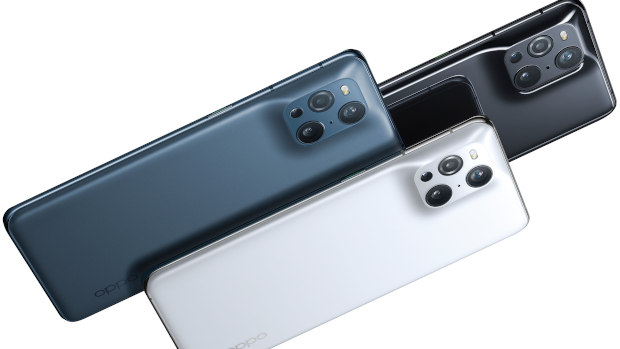You might not be familiar with Oppo, but according to researchers at Counterpoint, the Chinese brand (which owns OnePlus and Realme) holds a massive 16% global market share, second only to Samsung and marginally ahead of Apple and Xaomi.
This year Oppo began its play for the Irish market with affordable smartphones available through Three, Vodafone and eir. The Oppo A15, A16 and A53 will be familiar as competitors to Samsung’s A series, Nokia’s G series and Xaomi’s Redmi line. Oppo’s mid-market is handled by the Reno, which tops out at around €800.
The top end Find X3 series makes the move from 4G to 5G and comes in three flavours: the Lite, the Neo and the Pro. You’ll find the Lite and the Neo on the shelves either as a free upgrade for bill pay customers, or up to €650 for prepay, putting it in the line of fire of Samsung’s S20 FE 5G.
Today we’re taking a look at the flagship Find X3 Pro, which comes in at €1,300, putting it up against the iPhone 13 and Samsung S21 Ultra 5G on price. So how will it perform based on spec?
The Find X3 Pro measures 6.44×2.91×0.33” and weighs 193g, giving it a little heft but nothing out of the ordinary. The 6.7” screen is protected by Corning Gorilla Glass 5. The display’s 1440×3216 pixel resolution in a 20:9 ratio puts it ahead of the competition for resolution but a little behind when it comes to brightness. The fingerprint scanner lives under the display, meaning there is little to no bezel.
As expected, the on and volume buttons are on opposite sides of the unit. Charging is by UCS-C and the dual-SIM feature is a welcome addition. Unfortunately, we are deprived of a 3.5mm headphone jack, something I’ll have to make my peace with as true wireless earbuds gain traction in the market.
Under the hood we have some familiar features. An Android 11 implementation is augmented by Oppo’s ColorOS 11.2. It works smoothly and our review model was free of bloatware, sticking with Google apps instead of bespoke alternatives. I liked having the option to change the numbers of rows and columns.
As with the US/China edition of the Galaxy S21, the Find X3 Pro uses a Qualcomm SM8350 Snapdragon 888 5G processor and Adreno 660 GPU. Beyond the US and China the parts are different, but one imagines the performance is comparable.
There are three internal storage options: 256GB with a choice of 8GB or 12GB RAM, and 512GB with 16GB RAM. Whatever you decide to do, performance won’t be an issue.
The Find X3 Pro has a four-camera set up with equal prominence given to wide and ultrawide angle (both have 50MP sensors) followed by a 13MP telephoto with 2x optical zoom, and a 3MP microscope with 60x magnification. Giving the same prominence to wide and ultrawide cameras is familiar to iPhone users, but Oppo is far behind Samsung, which has prioritised the wide angle lens and gone for three additional cameras that, while competent, aren’t brilliant. Oppo’s decision to have two decent cameras without anything being exceptional makes it neither fish nor fowl. Videographers might take note that while the camera can film at 4K resolution, Samsung is already equipping their handsets with 8K cameras. The 32MP selfie camera is also let down by its lack of 4K capture. You’ll have to settle for 1080p.
For charging, the lithium polymer battery delivers 4,500 mAh and can get to 40% of charge within 10 minutes at 65W (wired). Wireless charging at 30W will get you a full charge in 80 minutes and the inclusion of reverse charging is nice, though I’m not sure how often I’ll use it.
Overall, the Find X3 Pro is competing in the spaces a tentpole smartphone should be: good battery, a solid display, ample storage and memory, and a decent operating system. The question of whether you should buy one comes down to the kind of camera you want. For stills, the Find X3 Pro is a good bet. For videographers, there are better options out there.
Niall Kitson







Subscribers 0
Fans 0
Followers 0
Followers